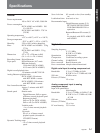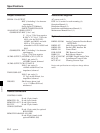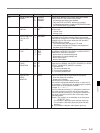
Glossary
A-6 Appendix
Appendix
Reference video signal
A video signal containing a sync signal or
sync and burst signal, used as a reference
for synchronizing video equipment.
Servolocking
The locking of the phase and speed of a
VTR’s head drum rotation and tape
transport to a reference signal during
recording and playback.
Standby-off mode
A mode in which head drum rotation is
stopped and tape tension is released, and
thus the VTR is not ready for immediate
recording and playback. This mode
alleviates the tape and video heads from
wear or damage.
Standby-on mode
A mode in which the head drum rotates
with the tape wrapped around it, and thus
the VTR is ready for immediate recording
or playback. The VTR enters standby-off
mode after remaining in standby-on mode
for a specified length of time to prevent
wear or damage to the tape and video
heads.
Time code
A digital signal recorded on the video tape
that supplies information such as hour,
minute, second and frame number for each
frame to facilitate the setting of edit points
or searching for specific scenes on the
tape. There are two types of time codes:
SMPTE (for the NTSC color system) and
EBU (for the PAL/SECAM color system);
and two time code recording formats:
longitudinal time code (LTC) and vertical
time code (VITC).
Tracking
The synchronizing of the head drum
rotation phase and tape transport phase
during playback and recording. Tracking
is adjusted to eliminate picture instability
when playing back material recorded on
another VTR.
Unloading
Also called “unthreading.” A process by
which the VTR winds the tape back into
the cassette case and ejects the cassette
from the slot. Normally, the VTR
automatically unloads the cassette when
you press the EJECT button.
User bits
A recordable 32-bit section in each time
code on a video tape for recording such
information as the recording year, month,
and day, and the tape or program ID
number.
Vertical interval time code
See VITC.
VITC
Abbreviation for Vertical Interval Time
Code. This is a time code recorded on a
video signal track during the vertical
blanking interval. It can be read correctly
even during slow or still picture playback.
See also LTC.


















